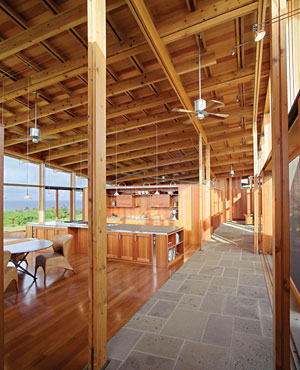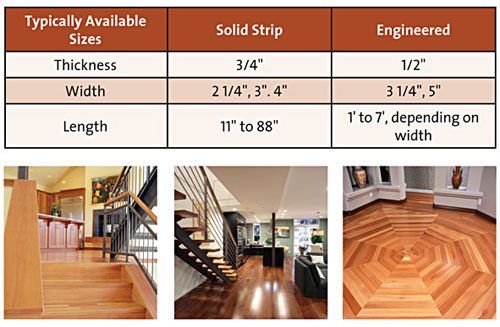Hardwoods in Green Building: Plantation-grown Eucalyptus Makes its Mark as a Versatile, Sustainable Exotic Species
Eucalyptus has a high strength-to-weight ratio and a hardness rating greater than white oak, mahogany, red oak, and is similar to hickory, hard maple or beech. Plantation-grown eucalyptus has a variety of working qualities that make it appropriate for interior applications. It has good machining and turning properties, without the "fuzzing" of mahogany. Eucalyptus also glues and holds fasteners well and sands to a smooth surface. With a relatively close grain, it takes all common types of finishing, including water and solution-based lacquers, various types of pigments, and oil and wax. All of these characteristics make the wood appropriate for diverse high-end applications like furniture, cabinets, flooring and architectural millwork products that are hardwearing. Eucalyptus is particularly well-suited to high-use interior situations as it maintains its appearance; it does not oxidize to a muddy brown as walnut does as it ages, nor does it fade like cherry.
The lumber of plantation-grown eucalyptus varies from red to light pink; the heartwood is a medium pink and the sapwood is paler. For customer convenience manufacturers may offer color sorting, in which they sort the lumber by color into three groups, say according to light, medium or dark pink. Most lumber yards tend to stock only one of the three tones depending on local preferences, assuring consistency in color.
 |
Eucalyptus was used in the interior of the Ohana House in Hawaii Photo © Art Grice |
Depending on the finish used, eucalyptus can be made to look like a temperate or tropical wood species and a light or dark effect achieved to complement a wide range of designs. In the Ohana House on the Big Island of Hawaii within a protected conservation zone, James Cutler FAIA of Cutler Anderson Architects, Bainbridge Island, Washington, specified eucalyptus finished with several coats of lacquer for the floors, casework and wall panels. The result is a crisp, honey-colored interior that is light and inviting. Cutler says that the firm always tries to use local materials, but that the native ohia was not long enough or available in quantity for this specific architectural application, so an imported eucalyptus hybrid was used. "We were drawn to the beauty of the wood," says Cutler. "It felt tropical and it was the right color to go with the lava rocks outside."
Traditionally, domestic eucalyptus has been known for its tendency to cup or warp. However, new methods of growing and harvesting the lumber have rectified the situation. Cutting the trees after 14 to 16 years of growth when they reach about 150 feet and have a diameter of 2 feet achieves the best results - superior to more quickly growing wood, and just as good as wood that takes longer to mature. Keeping the plantation grown eucalyptus straight enough to work is a function of many factors, beginning with careful handling when the tree is cut down and minimizing the time from harvest to opening up the log. The drying process is the single most important factor in keeping the wood straight and can involve air drying the lumber prior to kiln drying. The industry standard is to dry wood to 12 to 14 percent moisture content. Some eucalyptus manufacturers exceed that, drying lumber down to a 6 to 8 percent moisture content to assure a dimensionally stable product and to add value. In addition to being lighter and thus incurring reduced transportation and handling costs, dried timber is stronger than green timber; has better insulation properties; works, machines, finishes and glues better; and results in longer lasting finishes.
Applications of Eucalyptus
Eucalyptus is available in flooring, lumber and veneer for a wide range of residential and commercial applications. Manufacturers offer plantation-grown eucalyptus flooring in both solid strip lumber and engineered pieces. Solid strip eucalyptus flooring is harder than oak with the aesthetics of Brazilian cherry and typically costs less than walnut. Single-strip engineered flooring is made of a plywood base with a eucalyptus wear layer. As with solid flooring, some manufacturers offer tongue and groove construction, enabling it to be stapled, glued down or floated.
 |
Photos and chart courtesy of Weyerhaeuser |









